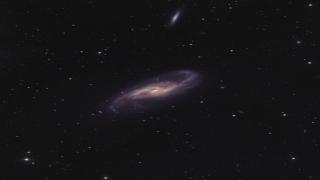Bibcode
Meidt, S. E.; Schinnerer, Eva; van de Ven, Glenn; Zaritsky, Dennis; Peletier, Reynier; Knapen, J. H.; Sheth, Kartik; Regan, Michael; Querejeta, Miguel; Muñoz-Mateos, Juan-Carlos; Kim, Taehyun; Hinz, Joannah L.; Gil de Paz, Armando; Athanassoula, E.; Bosma, Albert; Buta, Ronald J.; Cisternas, M.; Ho, Luis C.; Holwerda, Benne; Skibba, Ramin; Laurikainen, E.; Salo, H.; Gadotti, D. A.; Laine, Jarkko; Erroz-Ferrer, S.; Comerón, Sébastien; Menéndez-Delmestre, K.; Seibert, M.; Mizusawa, T.
Bibliographical reference
The Astrophysical Journal, Volume 788, Issue 2, article id. 144, 12 pp. (2014).
Advertised on:
6
2014
Journal
Citations
228
Refereed citations
215
Description
We present a new approach for estimating the 3.6 μm stellar
mass-to-light (M/L) ratio Upsilon3.6 in terms of the
[3.6]-[4.5] colors of old stellar populations. Our approach avoids
several of the largest sources of uncertainty in existing techniques
using population synthesis models. By focusing on mid-IR wavelengths, we
gain a virtually dust extinction-free tracer of the old stars, avoiding
the need to adopt a dust model to correctly interpret optical or
optical/near-IR colors normally leveraged to assign the mass-to-light
ratio Upsilon. By calibrating a new relation between near-IR and mid-IR
colors of giant stars observed in GLIMPSE we also avoid the
discrepancies in model predictions for the [3.6]-[4.5] colors of old
stellar populations due to uncertainties in the molecular line opacities
assumed in template spectra. We find that the [3.6]-[4.5] color, which
is driven primarily by metallicity, provides a tight constraint on
Upsilon3.6, which varies intrinsically less than at optical
wavelengths. The uncertainty on Upsilon3.6 of ~0.07 dex due
to unconstrained age variations marks a significant improvement on
existing techniques for estimating the stellar M/L with shorter
wavelength data. A single Upsilon3.6 = 0.6 (assuming a
Chabrier initial mass function (IMF)), independent of [3.6]-[4.5] color,
is also feasible because it can be applied simultaneously to old,
metal-rich and young, metal-poor populations, and still with comparable
(or better) accuracy (~0.1 dex) than alternatives. We expect our
Upsilon3.6 to be optimal for mapping the stellar mass
distributions in S4G galaxies, for which we have developed an
independent component analysis technique to first isolate the old
stellar light at 3.6 μm from nonstellar emission (e.g., hot dust and
the 3.3 polycyclic aromatic hydrocarbon feature). Our estimate can also
be used to determine the fractional contribution of nonstellar emission
to global (rest-frame) 3.6 μm fluxes, e.g., in WISE imaging, and
establishes a reliable basis for exploring variations in the stellar
IMF.
Related projects

Spiral Galaxies: Evolution and Consequences
Our small group is well known and respected internationally for our innovative and important work on various aspects of the structure and evolution of nearby spiral galaxies. We primarily use observations at various wavelengths, exploiting synergies that allow us to answer the most pertinent questions relating to what the main properties of
Johan Hendrik
Knapen Koelstra